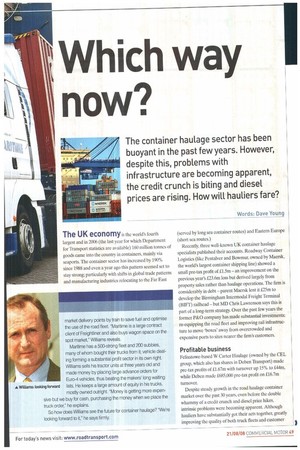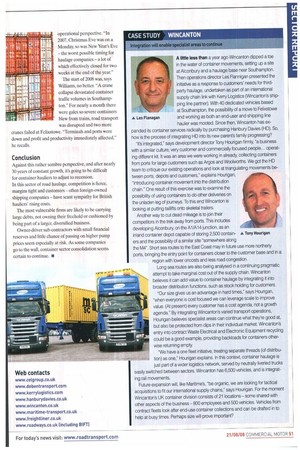Which way now?
Page 49

Page 50

Page 51

If you've noticed an error in this article please click here to report it so we can fix it.
The container haulage sector has been buoyant in the past few years. However, despite this, problems with infrastructure are becoming apparent, the credit crunch is biting and diesel prices are rising. How will hauliers fare?
Words: Dave Young
The UK economy is the world's fourth largest and in 2006 (the last year for which Department for Transport statistics are available) 160 million tonnes of goods came into the country in containers, mainly via seaports. The container sector has increased by 190% since 1988 and even a year ago this pattern seemed set to stay strong; particularly with shifts in global trade patterns and manufacturing industries relocating to the Far East (served by long sea container routes) and Eastern Europe (short sea routes.) Recently, three well-known UK container haulage specialists published their accounts. Roadway Container Logistics (like Pentalver and Bowmur, owned by Maersk, the world's largest container shipping line) showed a small pre-tax profit of £1.5m — an improvement on the previous year's £23.6m loss but derived largely from property sales rather than haulage operations. The firm is considerably in debt — parent Maersk lent it £25m to develop the Birmingham Intermodal Freight Terminal (flIFT) railhead — but MD Chris Lawrenson says this is part of a long-term strategy. Over the past few years the former P&O company has made substantial investments: re-equipping the road fleet and improving rail infrastructure to move 'boxes' away from overcrowded and expensive ports to sites nearer the firm's customers.
Profitable business
Felixstowe-based W Carter Haulage (owned by the CEL group, which also has shares in Deben Transport) made pre-tax profits of £1.67m with turnover up 15% to £44m, while Deben made £685,000 pre-tax profit on £16.7m turnover.
Despite steady growth in the road haulage container market over the past 30 years, even before the double whammy of a credit crunch and diesel price hikes, intrinsic problems were becoming apparent. Although hauliers have substantially got their acts together, greatly improving the quality of both truck fleets and customer 3 service, rail and road infrastructure has been groaning under the weight of the rise in traffic. The top three container ports in terms of units moved — Southampton, Felixstowe and Tilbury — are in effect the start of the final UK leg of an international supply chain journey. Yet the south-east of England has reached near gridlock on daytime road traffic and has a railway system suffering from years of under investment — and the prioritisation of passenger travel cannot accommodate many more rail freight movements. Commercial property prices have been ludicrously high for years and ports are running out of capacity and space to expand. Felixstowe is redeveloping to improve container and RO-RO facilities, but the single line rail route serving the port is fully used and, as every professional driver knows only too well, the A14 is a constant nightmare. The government, poorly advised and fixated on hub and spoke road routes to and from London, has failed to grasp the importance of east-west transit and there's nothing in its latest spending plans for the beleaguered dual carriageway. Schemes are afoot — albeit several years away to expand port tsrarnahrl
p x yg ewe No.1
p_kVINATION FOLLOW Landward Terminal la Trinity Terminal TIT
Tomtine House IF capacity in the Thames estuary, but in Southampton attempts to relocate the container quays across the harbour to Dibden Bay were kicked into touch for environmental reasons.
As southern ports struggle to cope, so container logistics has migrated northwards. Smaller harbours — such as Stobart's development of Weston near Runcorn — are emerging while larger locations, notably Humberside and Teesside, are increasing traffic. New RO-RO services have started on the west, south and east coasts of Britain and the number of rail-linked inland container terminals is growing rapidly.
Hard times ahead However, UK container hauliers service a consumer economy, predicated on continuing economic growth; as the recession bites and mortgages and redundancies rise, high-street sales fall. This has yet to hit container freight volumes in a statistically significant way since much current traffic is based on last year's advance orders, but there's an intuitive feeling among insiders of hard times ahead. Fashion stores aren't the only shops suffering, as John Williams at Maritime Transport points out, it's estimated people spend around £10,000 on 'big ticket items' (new furniture and white goods) when they move house, and the residential property market is stagnant. Factor in the dramatic rise in fuel costs, which an exchequer, desperate to sustain tax revenue to bail out the City, is unlikely to reduce, and prospects look poor.
If such macro economic issues weren't bad enough, Williams reckons 2008 also had a disastrous start from an operational perspective. "In 2007, Christmas Eve was on a The start of 2008 was, says Williams, no better. "A crane collapse devastated container traffic volumes in Southampton." For nearly a month there were gales so severe containers blew from trains, road transport was disrupted and two more cranes failed at Felixstowe. "Terminals and ports were down and profit and productivity immediately affected," he recalls.
Conclusion
Against this rather sombre perspective, and after nearly 30 years of constant growth, it's going lobe difficult for container hauliers to adjust to recession.
In this sector of road haulage, competition is fierce, margins tight and customers often foreign-owned shipping companies have scant sympathy for British hauliers' rising costs.
The most vulnerable firms are likely to be carrying large debts, not owning their freehold or cushioned by being part of a larger, diversified business.
Owner-driver sub-contractors with small financial reserves and little chance of passing on higher pump prices seem especially at risk. As some companies go to the wall, container sector consolidation seems certain to continue. •












































































































































































